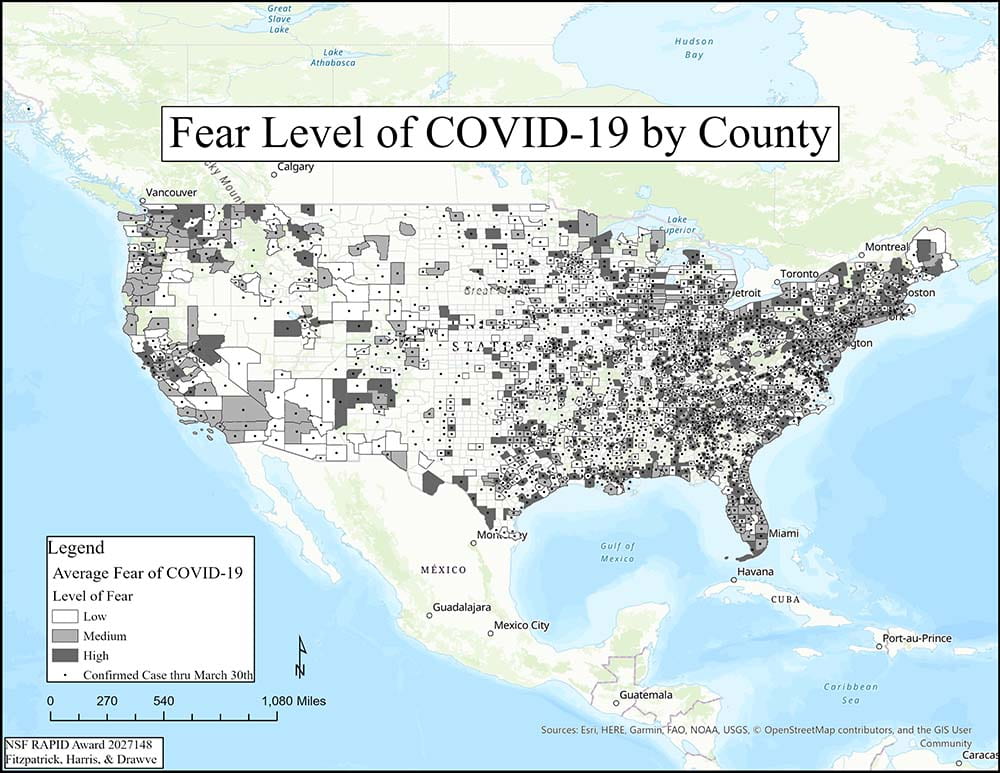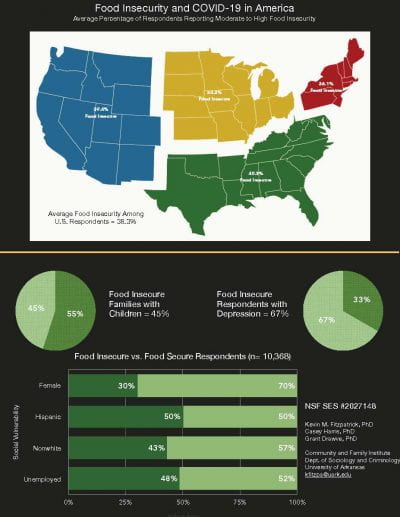Researchers Study Rising Mental Health Crisis in the Age of the Coronavirus

When lockdown orders began in March, University Professor of sociology Kevin Fitzpatrick saw an opportunity to study how people would cope with isolation, fear and economic uncertainty. With team members Casey Harris, associate professor of sociology, and Grant Drawve, assistant professor of criminology, Fitzpatrick applied for and received a Rapid Response grant for $185,000 from the National Science Foundation to conduct a nationwide survey of 10,368 adults to assess the mental health aspects of the pandemic.
“Our data reveal the dark side of quarantine and the uncertainty associated with a virus outbreak; a large proportion of respondents reported high levels of depressive symptoms, elevated levels of fear or concern for their own families, or were struggling with food insecurity because of broken food systems and limited access,” Harris said. “The sheer scope of social problems is not something we observe in most surveys and it highlights the unique circumstances the country now faces.”
Together, the team has published six papers on the social and psychological effects of the global pandemic, including work on how specific groups and communities differ in their levels of fear, suicidality rates, food insecurity prevalence and rates of depressive symptomatology.
Most recently, they found that respondents in 20 states reported higher than average percentages of food insecurity. The highest rates were found in Alabama, Arkansas, Kentucky, North Carolina, Tennessee and Texas.
“It is hard for most Americans to understand the complexities of food insecurity,” Fitzpatrick explained. “The idea that somehow online shopping for food would be the answer to addressing needs during the pandemic is not something that most Americans struggling with food insecurity can comprehend. People living in poverty are bombarded by a complicated set of problems that Instacart or Amazon food delivery won’t solve. Sustainable solutions to food delivery and access are complicated generally, and even more so for those persons living in poverty during a public health crisis.”
In their recently published article titled “Living in the Midst of Fear: Depressive Symptomology Among U.S. Adults During the COVID-19 Pandemic,” published in the journal Depression & Anxiety, Fitzpatrick, Harris and Drawve examine “the role of specific vulnerabilities, stressors, and resources as correlates of depressive symptomology in the context of uncertainty during the COVID-19 pandemic in the United States in mid-to-late March 2020.” They measured three stressors among respondents: fear, physical symptoms and food insecurity. They also examined three resource variables: strength of social ties, mastery of fate and levels of optimism. Controlling for all of these risks and resources, the research team found significant differences between the socially vulnerable, with “females, unmarried respondents, Hispanics and persons not working reporting higher depressive symptoms than their counterparts.” Moreover, “the independent influence of fear on depressive symptomology remained strong,” the team wrote.
“We went into this project assuming that there was no way that fear wasn’t going to vary across the country. We were convinced of that and developed several hypotheses that we wanted to test focusing on that diffusion and what might account for it,” Fitzpatrick said.
Another factor analyzed in this survey was the rate of suicidality, which is the tendency of a person to have thoughts and/or seriously consider committing suicide, among adults. In their recently published article “How Bad Is It? Suicidality in the Middle of the COVID-19 Pandemic,” published in the journal Suicide and Life-Threatening Behavior, the researchers found suicidality rates “not equally distributed across socially vulnerable population subgroups.”
An unexpected result of the overarching mental health analysis concerned the age of the respondents, said Fitzpatrick. Their studies showed that, “Younger people were more depressed; younger people were more anxious; younger people had a higher prevalence of suicidality. I think we expected that older respondents, particularly because of their heightened vulnerability, would be those reporting more negative mental health symptoms, but it was typically younger respondents. But when we examine fear, older people were actually more fearful, more worried and felt a greater sense of threat from the coronavirus than younger respondents did.”
Ideally, the team would like to conduct a second survey to examine the levels of fear, depression, suicidality and food insecurity now, after several months of rising COVID-19 infections, hospitalizations and deaths. With more than 200,000 lives claimed, there are a whole new set of challenges facing Americans, such as the return to school and work, that are being met with uncertainty and mixed feelings. A second survey would help researchers better understand how individuals are responding.
“How fearful are individuals now?” Harris said. “How has fear changed over time as the virus has touched nearly every community in the United States? Are those individuals and communities who expressed little concern early on more wary now? What impact has an entire summer’s worth of restrictions had on the mental and physical health, educational aspirations, or employment prospects of young adults? I think all of these questions are things we would love to examine if we could conduct another survey, which would allow us to untangle the more nuanced aspects of how COVID-19 has upended the lives of different groups in the United States.”
In their most recent article “Facing New Fears During the COVID-19 Pandemic: The State of America’s Mental Health,” published in the Journal of Anxiety Disorders, the researchers conclude, “Much work is needed in explicating the complicated set of relationships between social and behavioral circumstances, public health reactions, and mental health consequences of adults living through the pandemic in the United States.”




You must be logged in to post a comment.